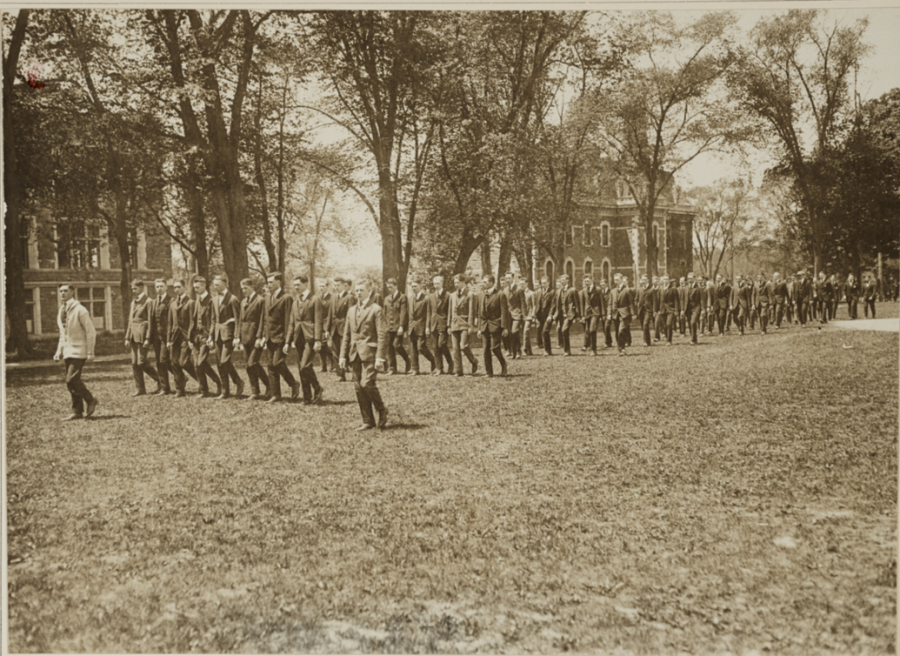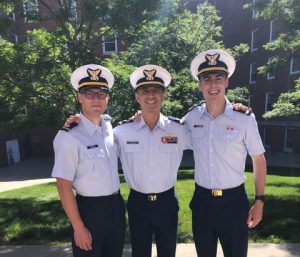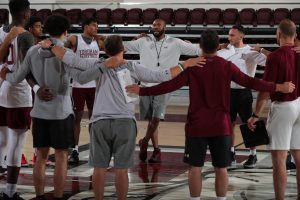‘The Will of God’: How Fordham Threw Itself At World War I
Catholic Clergymen in New York encouraged young men to fight in 1918, drastically altering the landscape of Rose Hill
COURTESY OF FORDHAM ARCHIVES
The Fordham Ambulance Corps marches on Edwards Parade before being shipped to the front in 1918
May 4, 2022
Amid the commotion of the Bronx at midday, thousands of students, faculty and staff come and go through the gates of Rose Hill. At the Third Avenue entrance to the campus stands a testament to the Great War and the sacrifice it demanded. The wrought iron gate is flanked by blank stone columns. How many people scan their IDs, walk through and fail to see this memorial? Only a statistical few will take notice of the patina-bronze plaque, dotted with 36 names.
Embedded in the history of the Catholic Clergy in New York City and intertwined with American politics of the early 20th century, this memorial represents far more than the Fordham men who gave their lives in the muddy trenches of the Somme and Verdun in 1918.
Long before Fordham University was a nationally recognized institution, Catholic figures in New York used religious fervor to encourage young students to join the global conflict, claiming it to be God’s will. Recorded in the history of the university are the keen observations and sometimes glowing admiration of Fordham students, attesting to the power of institutions and the impact of World War I on a peaceful collegiate community.
Fordham Enters the War
While World War I had been raging in Europe since 1914, America remained neutral for the first three years of the war. Until 1917, life at Fordham University (then known as St. John’s College) was typical. United States President Woodrow Wilson declared war in April of that year in response to unrestricted submarine warfare by the German Empire. The war changed the university almost immediately.
An all-male school at the time, Fordham was strictly administered by Jesuits. The president of Fordham University in 1917, the Rev. Joseph P. Mulry, S.J., had drastically reorganized the institution. In 1916, he established three graduate programs: the Graduate School of Social Service, the Graduate School of Arts and Sciences, and the Graduate School of Education — programs originally housed in the Woolworth Building in the Financial District of Manhattan, a precursor to today’s Fordham Lincoln Center campus.
Mulry was viewed as a leading voice in the Society of Jesus in the United States and was highly respected by his peers. According to historian Thomas Shelley, who wrote “Fordham: A History of the Jesuit University,” American Catholics were viewed as apathetic. They weren’t thought of as particularly patriotic. Within the Catholic Clergy in the United States, there was also nativist fear of the Pope. These characteristics changed drastically when America entered the war, and at Fordham, Mulry drove the change.
The Church’s Call
When the declaration went out in 1917, the nativist fear among Catholics quickly turned to vehement hatred of the German kaiser and hysterical contempt toward Germans — a major ethnic group in America at the time, according to Shelley. In an attempt to prove their patriotism, American Catholics enlisted in droves. At Rose Hill, the collegiate student body was rallied by war cries delivered by Mulry himself.
“When the call came from Washington for men and arms, it was as though God Himself stood in my presence and said: ‘I, Myself, call you to war,’” Mulry said.
“In this dark hour of trial, the sons of Fordham, past and present, are enlisted in your support to the last man.” Editors of the Fordham Monthly
His words echoed those of bishops across the nation who wanted to confront the doubts among Americans about the loyalty of Catholics to the flag. American clergymen made grand speeches claiming divine approval of the conflict. Students at Fordham heard the words of the clergy and the calls to action by Mulry.
“In this dark hour of trial, the sons of Fordham, past and present, are enlisted in your support to the last man,” the editors of the short-lived, student-run magazine the Fordham Monthly, said in an open letter to Wilson.
Ambulances at Rose Hill
The months following the declaration set the stage for recruitment efforts of enormous proportions. At Rose Hill, Mulry established the Fordham Ambulance Corps, sometimes called the Fordham Overseas Ambulance Corps, with 127 men.
According to a New York Times article published in June 1917, Fordham alumni donated four ambulances to the university. The ambulance men were sent to train at Camp Crane in Allentown, Pennsylvania, with other units of the newly minted United States Army Ambulance Service (USAAS).
The USAAS was made up of units from colleges across the country. At Allentown, Fordham men were joined by Yale and Harvard recruits. They trained hard for months and found leisure by creating a baseball team. They competed against multiple colleges, including Fordham’s legendary squad led by future Baseball Hall of Famer Frankie Frisch.
By the end of the war, 46 of its members had received the Croix de Guerre, a medal for valiant service.
When the men of the Ambulance Corps were deployed, they formed multiple units, all led by Captain Joseph E. Donnelly, a professor at the now-defunct Fordham Medical School. Sections 551, 552 and 553 were composed of Fordham men and they supported the French army in the conflict by evacuating wounded troops.
By the end of the war, 46 of its members had received the Croix de Guerre, a medal for valiant service. They had seen combat in Verdun and the Somme, two of the most brutal battlefields of the war. The final major American offensive in the war was at the Somme, known as the Meuse-Argonne; it was also the largest in American history, involving over 1.2 million soldiers.
Rose Hill Is Transformed
At Rose Hill, the drumbeat of the U.S. Army persisted. Mulry did not stop after forming the Ambulance Corps, claiming that Fordham’s participation in the war was the “Will of God.” In an address at the Cathedral of Saints Peter and Paul in Philadelphia, he said, “This war will purify the soul of the nation.”
To uphold his fiery speeches, Mulry established the Student Army Training Corps (SATC) in 1918. The Corps was led by military officers, and its primary purpose was to instruct Fordham students on military practices and tactics. The gymnasium became a mess hall, and multiple residential buildings became barracks. Academic classes were replaced with classes on warfare. Drill was regularly performed on Edwards Parade.
The SATC existed for only two months before the armistice in November of 1918, but it changed the landscape of the university forever. In 1919, the yearbook, known as The Maroon, said that enough Fordham men signed up to form eight separate companies at Rose Hill, around 500 people total. The halls emptied, and uniforms paraded across the fields.
The Maroon estimates over 1,800 students enrolled at Fordham served during the entirety of the United States’ engagement.
Fordham was marked by the presence of the Army, but even before the SATC, Fordham students and alumni shipped off en masse. Thousands are estimated to have left for France, including young boys from the Fordham Preparatory School who lied about their age. Many Fordham men rose quickly through the ranks. The Monthly claims that three Major-Generals, ten Chaplains and 140 lieutenants represented the university as officers.
Many of the Fordham troops fought under Major John F. O’Ryan, who organized the New York National Guard and led them in battle. O’Ryan’s 27th Division went on to become the 27th Infantry during World War II and fought in the Pacific.
Although the exact number of Fordham community members that served in the war is not known, the two closest sources providing an accurate approximation of Fordham servicemen are Father Robert Gannon and The Maroon.
Gannon claimed that 1,529 Fordham Alumni were in the service of the U.S. Army when General John J. Pershing arrived in France, including the Fordham members of the USAAS. The Maroon estimates over 1,800 students enrolled at Fordham served during the entirety of the United States’ engagement. Of those who served, 36 died.
The precise number of students enrolled in 1917 and 1918 is unknown. The Catalogue of Fordham University from 1924 indicates 4,000 students were enrolled. Shelley describes how Fordham dramatically increased its enrollment in the roaring twenties, therefore the enrollment number in 1924 is likely significantly higher than that of 1917 or 1918.
The Class of 1919
Little is known about the stories of the men who served, as names are the only records that remain. According to the Monthly, three adolescents of the Fordham Preparatory School died together. The Monthly also contains a list that provides names of honor roll students who fought.
Additional names appear in archived New York Times articles referencing graduate students or alumni who contributed to the war. The Fordham Ram also published multiple profiles of Fordham students serving in various branches of the military.
However, the best personal stories of these heroes lie in The Maroon. Due to the SATC, there was no Maroon for 1918, but production resumed the following year. The Maroon chronicled the history of the class of 1919, from freshman year until their tumultuous junior and senior campaigns.
James Patrick Pryor was a student whom the class of 1919 missed sorely. Pryor was the Managing Editor of The Fordham Ram and a third-year student. When the war broke out late in his junior year, he enlisted in the U.S. Navy. He died of the Spanish flu during his training.
Many more Fordham men served and died in the trenches of the Western Front. But some of the best recorded stories, particularly in The Maroon, are of the men who returned.
Cornelius Godley was an artilleryman who returned to manage the Fordham tennis team. Cyril Higgins played football and ran track. During the war he was deployed to Naval Station Puget Sound in Seattle.
The deep connection between the U.S. Army and Fordham University lingers in the modern Reserve Officer Training Corps on campus.
John MacCarthy was a Master Sergeant with the SATC. He wrote for The Ram and the Monthly and graduated summa cum laude.
Gilbert Haggerty was of the class of 1918. He was not able to graduate, like many of the class of 1918, due to his service. He joined the class of 1919, and it was said that he would rush at any opportunity to put down his class work and join a game of baseball.
The Memorial at Third Avenue
These are only some of the men whose records remain. Many more are lost to history. Ultimately the war touched the souls of every student at Rose Hill. Father Edward P. Tivnan, S.J., president of Fordham University from 1919 to 1924, later commemorated the sacrifice of the 36 Fordham men who died in service of the United States.
On November 22, 1920, the Memorial Gateway at the Third Avenue entrance of Rose Hill was unveiled with a large religious and military ceremony. Thousands of graduate and undergraduate students, entire Army regiments and recently promoted General O’Ryan were in attendance.
The 36 names of the Fordham servicemen who died in battle etched in the memorial represent far more than an ultimate sacrifice. As they stand today, they contain the shared memory of a bizarre and extraordinary time in the history of Fordham University.
Through institutional pressures, a global war radically changed the lives of thousands of young men. The legacy of Mulry’s tenure remains in the graduate programs. The deep connection between the U.S. Army and Fordham University lingers in the modern Reserve Officer Training Corps on campus.
These stories of the early 20th century are poignant reminders of the impact of war and politics on young people. The university is not isolated from the intrigue and events of the modern world. Thirty-six Fordham graves can attest to that.
Get the latest Fordham sports updates on your Twitter feed. Follow The Observer’s sports Twitter page here.

















Don't Worry About It • May 9, 2022 at 8:35 pm
The Fordham Ram was founded to deliver news to the front to Fordham men in World War I, right? Surprised the very explicit Fordham Ram / World War I tie wasn’t detailed in this article, but pretty good nonetheless